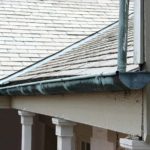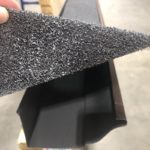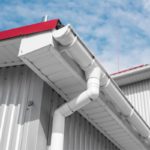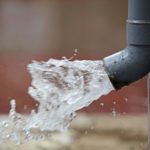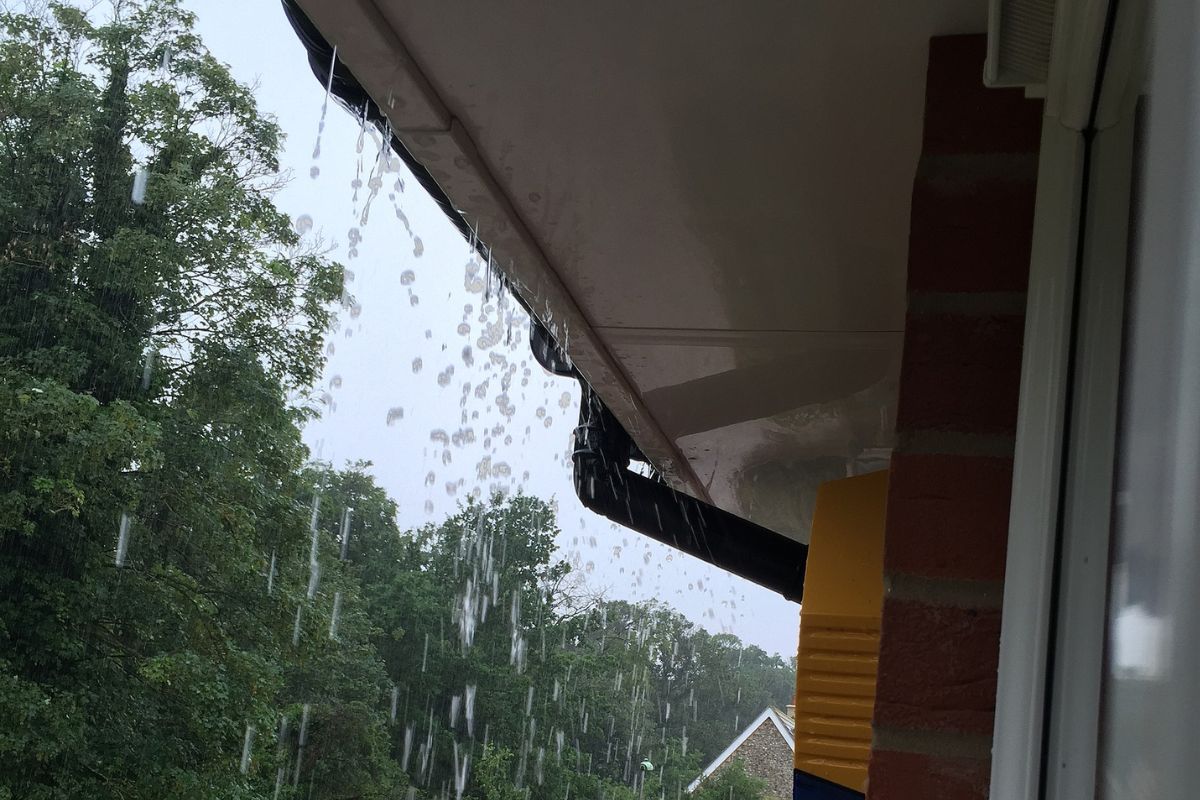
Your gutter system prevents water damage to your home by redirecting the flow of rainwater and snowmelt. But because a gutter is, in the simplest terms, a trough that leads excess water into a drain pipe, it’s fair to wonder whether it can overflow in heavy rain. This article will discuss the possibility of a gutter overflowing and what to do to prevent that from happening.
Table of Contents
- How Do Rain Gutters Handle Heavy Rain?
- 4 Common Causes of a Gutter Overflow
- Signs of a Gutter Overflow
- How to Prevent Overflowing Gutters
- FAQ About Gutter Overflows
How Do Rain Gutters Handle Heavy Rain?
A rainstorm can bring more than a steady patter on your roof. There are times of the year and areas of the country where homeowners see heavy rainfall consistently. If you have a gutter system, you may be wondering whether the gutter could overflow during a downpour.
The answer is that, yes, a gutter certainly can overflow during a heavy bout of rain. Though most gutters are designed to prevent this situation, some circumstances and conditions can lead to your gutters being overwhelmed by a large amount of water.
4 Common Causes of a Gutter Overflow
A heavy downpour can present your gutter with more water flow than the system can handle. However, there are other reasons for this issue to arise. The four most common causes of overflowing gutters include the following.
1. A Clog in the System
A clog is one of the most common causes of an overflowing gutter, as well as a common gutter problem in general. The downspout is a closed section of pipe that acts as a drainage system within a gutter run. When the downspout becomes stopped up with debris, it’s no different than a clogged drain in your sink or bathtub. Water goes down too slowly or not at all, filling the gutter until it spills over the sides.
2. Lack of Drainage
Even if you aren’t dealing with clogged gutters, the downspouts can handle only so much water at one time. That is why some gutter systems include multiple downspouts to drain water much faster. If your gutters don’t have enough downspouts, you may face an overflow.
Downspout placement also matters significantly. If your downspouts are too close together or too far apart, it will allow water to sit for a longer period before draining. The longer it takes for water to drain, the faster these spaces will fill during a downpour, leading to an overflow or standing water that will overflow the next time it rains.
3. Gutters That Are Too Small
The size of your gutters also plays a part in the potential for a clog. If the gutter run doesn’t have enough space to accommodate the flow of water, that water will spill over. Many residential homes have 5-inch K-style gutters, which are typically wide enough for normal amounts of rain. But, these gutters may not provide enough space to prevent an overflow in torrential downpours.
4. Improper Tilt or Pitch of Your Gutters
When water collects in your gutters, it should automatically run toward the downspouts. This is because gutters are slightly pitched toward the drains.
However, if the gutter pitch is too shallow, water may not flow toward your downspouts as quickly, giving it a chance to pool in parts of your gutter until it overflows. Alternatively, too steep of a pitch may cause the water to slosh in one direction too rapidly and splash over the sides or ends of the gutter.
In addition, if the fasteners used to connect the gutter to the fascia boards of your roof become worn out, the gutter could potentially tilt away from your house. This tilt causes your gutter to sag.
Signs of a Gutter Overflow
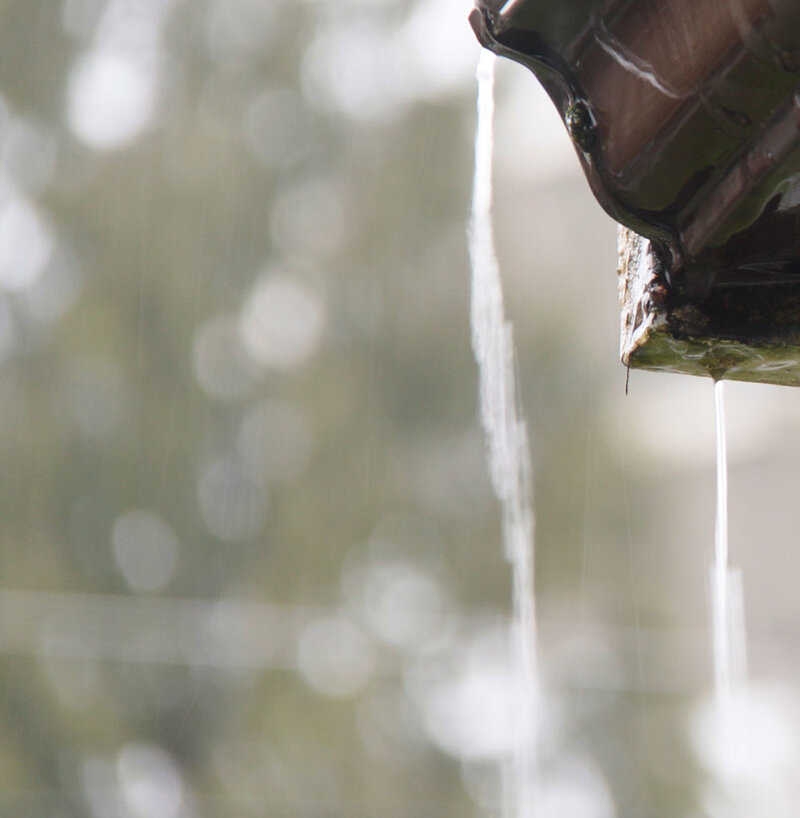
Unless you stand outside in the driving rain watching your gutters diligently, you may not realize that they overflow until you notice the effects the water has on your property. Be on the lookout for:
- Soil erosion occurring under your gutters
- Water damage to your home’s foundation or landscaping
- Discoloration or water damage down the sides of your home
It’s vital to note that these signs primarily indicate an overflow if your gutters aren’t damaged or leaking.
How to Prevent Overflowing Gutters
Fortunately, there are solutions to the most common reasons for your gutters to overflow. And many of those solutions are of the DIY variety. Here are the steps you can take if you would like to avoid or resolve an overflow problem.
Dealing with Clogs
As time goes on, debris such as leaves, twigs, and bits of trash blown by the wind can build up inside your downspouts, clogging them. It’s vital to clear any blockage from your downspout to provide water with a wide-open path away from your property. Knowing how to clean your downspout thoroughly as part of regular gutter maintenance will allow you to keep the pipe clear all year round.
If you want to prevent clogged gutters from becoming a significant issue, you should invest in some quality gutter guards. Not only can they keep your gutters clear of debris, but they have many benefits that range from alleviating problems to making home improvement projects easier.
Provide Adequate Drainage
Your downspouts can drain only a certain amount of water at one time, so it would be greatly helpful to ensure that there are enough downspouts for your gutter. In addition, these drainage pipes should be spaced in a way that allows the water to drain evenly and fully. A good rule of thumb is to place downspouts no closer together than 20 feet and no further apart than 50 feet.
Install Appropriately Sized Gutters
If you have a water overflow problem even with clean and clear downspouts, it may be time to install wider gutters. While 5-inch gutters are typical, 6-inch gutters can hold as much as 50% more water, making a significant difference. And whether your gutters are K-style or half-round, you should choose your downspout size according to the drainage capacity of your gutters.
The appropriate size of your gutters and downspouts has multiple influences, including the size of your home, the amount of rainfall you experience, and how much runoff from the roof you are expecting during a heavy rainstorm. Take every factor into consideration when determining the right gutter size for your home.
Check the Positioning of Your Gutters
The pitch and tilt of your gutters can go a long way in determining whether water drains properly or overflows. When checking your gutters, you can use a level to measure the degree of your gutter’s slope. Generally speaking, there should be between an eighth of an inch and a quarter-inch of slope toward the downspouts for every 20 feet of gutter.
If the pitch of your gutter is too far toward the downspout or too far away from it, you can re-hang your gutters if you’re confident about getting the angle right. However, it may be more prudent to consult a gutter installation expert about adjusting the position of your gutters.
It would also be best to check the connection between your gutter and the fascia boards. If the hanging mechanism is worn down or shows signs of damage, replace it as soon as possible. Your gutters could tilt away from your house, and the weight of the water in them could worsen the problem over time.
Install Splash Guards
Sometimes, unclogging your downspout or using the largest gutters you can install on your home will not fully remedy a small amount of overflow. If you live in an area that sees extremely heavy amounts of rain or even hurricanes, your gutter system may become overwhelmed by the sheer volume of water. You can prevent this by installing splash guards on your gutters.
Splash guards are small pieces of vinyl that are mounted to the edges of a gutter to help prevent water from sloshing out. They can be straight or curved to fit on corners where fast-moving water may not stay in the gutter during sharp turns.
FAQ About Gutter Overflows
Though they cause similar problems, an overflow and a leak are different. When a gutter overflows, water splashes up over the edges of it in varying amounts. If a gutter leaks, that means that the water seeps or drips consistently from a break or hole in the gutter.
If the connection between your gutter and the fascia boards that hold them up is weak, water could splash back under the eaves of your roof and eventually rot the wooden fascia boards. Mold would develop from standing water trapped in nooks and crannies of your roof eaves, and moldy standing water only encourages an infestation of various pests and vermin which would further damage your roof.
When to Call a Gutter Specialist
The weather can throw you a curveball sometimes, and a drizzle can turn into a downpour. You don’t want to have to deal with overflowing gutters when that heavy rain occurs. From gutter cleaning services to resizing your gutters and helping you choose the right gutter guards, get in touch with a local gutter specialist to find a solution to all your needs.
Main Photo by: AzurevacR / Wikimedia Commons / CC BY-SA 4.0

